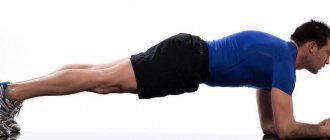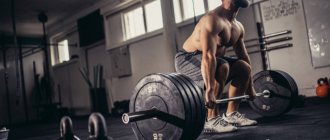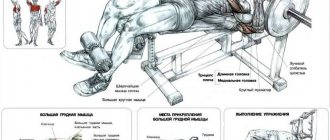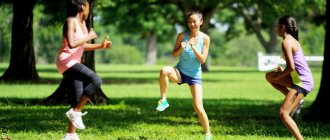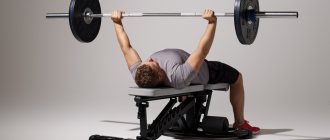If you want to grow and strengthen your upper body muscles, as well as develop strength and improve your performance in other exercises and sports, you should do the barbell press. This can be done in different ways, based on the purpose of the training, and today we will analyze in detail what a bench press is, how to do it correctly, what options and mistakes there may be.
- Bench press on a horizontal bench - what muscles work
- Benefits and Benefits of Exercise
- Exercise options
- Classic bench press - how to perform the program correctly
- Press with touch
- Power Rack Press for Beginners
- Bench angle
- Positive slope
- Negative slope
- Video: Head down press
- Option “guillotine” - a technique to increase breast size
- Video: Guillotine press
- Machine press - Smith machine
- Reverse Grip Press
- Video: Reverse Grip Press
- Narrow and wide hand placement
- Wide stance
- Narrow staging
- Floor press
- How many repetitions and sets should you do?
- Press for girls
- Mistakes when pressing - how to grip the bar correctly, breathe, where to lower it
- Video: Common mistakes when performing bench presses
- Alternative exercises that can replace workouts
- Interesting Facts
- Video: World Record, Ryan Kennealy
Correct bench press: technique
The first question that friends and acquaintances will ask you when they find out that you go to the gym is “How much do you bench?” It just so happens that the number of kilograms on the bar determines your “coolness”.
And probably everyone who gets into the gym tries to increase their strength in this particular exercise. And the first thing you need to do for this is to master the correct technique.
- Proper technique will not only help you press the barbell with a lot of weight, but also minimize the risk of injury. The more weight on the bar, the more tense the muscles and ligaments
- The starting position is very important in this exercise. You don't just need to lie down on a bench and grab the barbell with your hands. You need to arch your back (“bridge”). This will help to better coordinate the body and reduce the range of motion of the barbell. The distance from the top of the chest to the highest point will become smaller
IMPORTANT: In the initial position of the bench press, you need your body to touch the bench at three points: your buttocks, your shoulder blades pulled together, and the back of your head. Squeezed shoulder blades help expand the chest and engage more muscles.
- Another important factor when bench pressing is proper foot placement. They should rest firmly on the floor and stabilize the body. Adjust the bench height for yourself. If this cannot be done, you need to place weights from the barbell in the places where your feet are positioned. Thus raising the place where the legs touch the floor
- Another important point is the orientation of the body relative to the barbell. In the starting position it should be at eye level. If it is behind them, then when squeezing, the bar will touch the racks. If the barbell is in front of your eyes, then additional strength will be required to squeeze it out
- You need to remove the barbell from the racks with the help of a partner. After removal, you need to hold it with outstretched arms and gradually lower it to the lowest point (top of the chest). The optimal mark is a point located just above (two fingers) of the solar plexus
IMPORTANT: In the amateur bench press, the grip width is determined independently. You need to determine the optimal width for yourself. One that will help you survive with a barbell of the required weight. Usually this is shoulder level, plus or minus a few centimeters.
- The grip for the bench press should be closed. This means that you need to hold the barbell so that your thumb is opposed to the other four.
- Professionals often use an open grip, that is, all five fingers are located on one side of the bar. But beginners are strictly prohibited from doing this. If the barbell falls out of your hands, it is fraught with severe injuries.
- After the barbell has dropped to your chest, you need to squeeze it to the top mark. When lowering the barbell, you need to tense up like a spring and when you touch your chest, begin the reverse movement
- At the same time, your “spring” should unclench, helping to squeeze out the weight that you planned. In this case, only your hands should move. And the muscles of the legs, back, chest and shoulders help them in this
IMPORTANT: You don't need to lower the bar as quickly as you raise it. When lowering, you need to accumulate energy and release it during the reverse movement. When lowering the barbell, you need to take a deep breath and, as you exhale, squeeze the barbell.
On large scales, the help of a belayer is very important. Just his presence can help you press the barbell with more weight. Never lie down on a bench without the help of a partner or trainer.
Three-day training split
First of all, before starting the program below, take a break from training for a whole week. Yes, for a whole week. If you want to do some cardio during this time period, that's great. But no heavy lifting. Giving your joints, muscles and various connective tissues a rest is very important.
In fact, it is highly recommended to take a scheduled week's rest every three to four months. Yes, for some of you this is difficult to do, but in the grand scheme of things, one week is not such a long time!
After a week's rest, your shoulders and elbows will be rested and feeling pretty good and ready for intense work, but you shouldn't jump into high-intensity training right away. No, you've probably done this in the past.
You will gradually increase the weights, the intensity of your training and this time actually get stronger.
Monday: legs
- Barbell squats – 4 sets of 6-8 reps
- Leg press - 4 sets of 6-8 reps
- Seated leg curls - 4 sets of 10-12 reps
- Standing calf raises - 4 sets of 15 reps
- Seated calf raises - 4 sets of 15 reps
Wednesday: Chest and Triceps
- Incline Dumbbell Press – 3 sets of 6 reps
- Bench press - 3 sets of 6 reps
- Close grip bench press - 3 sets of 6 reps
- Arm extension on the upper block – 3 sets of 8-10 reps
- French EZ-bar bench press - 3 sets of 6-8 reps
- Shoulder external rotation on a cable machine - 2 sets of 15 reps (each arm)
Friday: back and biceps
- Bent-over barbell row - 4 sets of 6-8 reps
- T-bar rows - 3 sets of 8 reps
- Lever Row - 3 sets of 8-12 reps
- Dumbbell lateral raises lying on an incline bench - 3 sets of 10-12 reps
- Hyperextension - 4 sets of 15 reps
- Barbell curls on a Scott bench - 4 sets of 6-8 reps
- Dumbbell Curls - 3 sets of 8-10 reps
- Shoulder external rotation on a cable machine - 2 sets of 15 reps (each arm)
This split plan is for three days a week. Now, for all those who work out five to six days a week, relax! We focus on increasing bench press strength. The less you exercise, the more time you have to recover.
Many guys train chest twice a week and include heavy bench presses in both workouts. And guess what? They are not the biggest or the strongest in the room.
Powerful powerlifters who train chest once a week and only hit the gym three days a week are the biggest and strongest. There is a connection here.
Since Universal Chest Day is on Monday, you will be training your legs on this day. Why? It's simple. The benches will likely be available on Wednesday and you won't have to wait to use them. Dig deep and force yourself to change days, surprise your muscles and let them begin to adapt to the new load plan.
Mondays will be all about legs, and Fridays will be all about back and biceps. On Wednesdays you will focus on the bench press, on this day you will do chest and triceps exercises.
You probably noticed something. No delt work. What about pumping up big delts? There will be no direct delt work in this program, with the exception of the rear delts on back day. There will be no lateral or front raises or overhead presses.
The front delts will get plenty of work when you bench press. The shoulder joints need sufficient rest to fully recover. If you think about it, most workouts place stress on the shoulder joint four to five days a week.
The shoulder joints are involved in pressing in any plane when working on the pectoral muscles and shoulders, as well as in training the back.
Instead of working the delts themselves, this program focuses on heavy bench pressing and strengthening the rotator cuff, which is a functional group of four muscles and their tendons located deep around the shoulder joint that serve to stabilize and rotate the humerus. This in turn influences healthy, balanced shoulder development.
Strengthening these muscles is one of the best-kept secrets of the bench press. Most people ignore their exercise. There are quite a few exercises for the rotator cuff, choose two exercises for yourself on Wednesday and two different exercises on Friday. Use very light weights and do no more than 15 repetitions.
This is best for these important muscles. Rotator cuffs need to be “persuaded”, not “condemned”! Don't worry about adding weight, just do high reps and be consistent with your exercises.
Remember that rotator cuff exercises should be done AFTER you complete your workout. Do not use them for warming up. Do them as strengthening elements after you finish all the other exercises.
People make the big mistake of doing them first and fatigue the rotator cuffs before doing heavy lifting. Training them first is not a warm-up; it is an invitation to trauma. Don't weaken an already weak link by working on it first.
Bench press for girls: debunking myths
Most representatives of the fair half of humanity, coming to the gym for the first time, want to make their stomach elastic and give their buttocks a more attractive shape.
As for the chest, exercises for this part of the body are not just ignored, but are completely excluded from the training program by women.
The thing is that they believe that with the help of such exercises you can lose your femininity. Of course this is not true. The bench press is as important for a beautiful figure as squats and other exercises.
Let's debunk a few myths:
- The bench press makes your chest smaller. This myth is based on the fact that female professional bodybuilders have flat chests. But, they acquired this shape not because of the bench press, but “thanks” to a strict diet and various sports pharmacology drugs
- The bench press makes the chest tight. Breasts are mostly made up of fatty tissue. When training the chest muscles, the fibers that are located under the fatty tissue are involved
- Bench pressing will not make fat harder . Yes, if training is aimed at losing weight, then some of the fat deposits will leave the chest. Making it a little smaller. But, training the muscles of this part of the body can give the breasts more prominent shape. What minimizes fat loss
- Push-ups are enough to form beautiful breasts. Some girls believe that only push-ups are enough to form beautiful breasts. This is wrong. Various exercises are important for the pectoral muscles. Actually, just like for other muscles of the body
Key nuance
The bench press is commonly used as a movement that is performed on a flat bench. Fans of innovation perform the exercise at an inclination downwards and upwards.
This is all a mistake.
The bench press in bodybuilding is about building a great figure, and not about trying to update your strength records. The horizontal bench focuses on developing the middle and lower chest. Tilt down - bottom of the pecs. At the same time, the 45-degree incline press shifts the emphasis to the deltoids and triceps. The upper chest is hardly trained.
The consequence is “saggy breasts,” like those of obese young ladies aged 60+. Especially noticeable in clothes.
The solution is to do most of the work at an angle of 20-30 degrees. This inclination is optimal for working the upper pectoral muscles.
Bench Press Assistance Exercises
- The bench press is a compound exercise that targets the entire upper torso. This means that auxiliary exercises for increasing strength in this exercise will be isolated exercises for each muscle involved in this exercise.
IMPORTANT: Not all coaches believe that auxiliary exercises should be included in bench press training programs. There is an opinion, supported by research from American experts, that such exercises can reduce the effectiveness of the main exercise.
- Isolation exercises are often used by beginners in the bench press. This is understandable; with the help of such exercises they are trying to develop their still weak muscles. Professional benchers use only special exercises that “cover” the weak points of their bench press
There are auxiliary exercises for:
- Improvements for lifting the barbell off the chest
- improving the passage of the barbell through the middle section of the amplitude
- boost improvement
- improving stabilization and negative phase
The key to success in the bench press is a powerful release of the barbell from the chest. Having gained the required speed, the barbell is able to “break through” the dead center, which will help increase the bench press.
- To train stalls, athletes use additional exercises such as presses with a pause at the bottom point and presses from low supports.
- To train the barbell to pass through the middle section of the amplitude, chains . During the bench press, the chains increase the weight of the bar in proportion to the amplitude. What helps to “close” a weak spot in the middle of the barbell’s range of motion
- The push-up is trained by limiting the movement of the barbell. Only the upper part of the amplitude is used. bars are placed on the athlete's chest . Their number depends on the height from which the booster will be trained. For this exercise, the weight on the bar should be greater than your working weight. Therefore, bar bench presses cannot be performed without belayers.
- To stabilize the movement of the barbell in the negative phase, use a reverse press . To do this, the weight of the bar must be 10% -20% higher than the working one. The spotter must remove the bar from the racks and help lift the bar to the top point. You need to lower the bar without the help of a spotter. This should be done slower than lowering the bar during a normal bench press.
Bench press training
- The training of this exercise depends on what goals the athlete sets for himself. After all, with the help of the bench press you can not only increase strength, but also develop a beautiful, powerful chest
- In addition, this exercise is basic, which means it “pumps up” not only the chest, but also the latissimus and deltoid muscles. And also triceps and biceps
- In any gym you can find beautifully built athletes who only do bench presses, squats and deadlifts. And at the same time, they do not torture their body with grueling isolating exercises that cannot ensure muscle growth.
- There are many systems used in bench press training. All of them are based on regularity, training after muscle recovery (2-3 days) and a gradual increase in the weight of the barbell
Is it true that you can’t gain weight without bench presses?
Increased muscle mass is the result of increased protein synthesis, which occurs due to increased testosterone production in response to ever-increasing physical activity. Only heavy basic exercises can trigger this process.
If you don’t do exercises with heavy weights (base), there can be no talk of any growth. We're talking about a natural way to build muscle without the use of exogenous testosterone.
Every time we lift a weight in a compound exercise, our muscles are working to the limit of their capabilities. This stimulates their growth and strengthening. The body is given a kind of signal that the available hormonal reserves are not enough for such hard work. As a result, more testosterone is produced - the main reason for the increase in strength and mass.
Thus, the bench press, as one of the basic exercises, directly affects these processes.
How to increase your bench press: training program
After a beginner comes to the gym, he must go through a period of adaptation of the body to training. At this time, you need to hone your technique. You shouldn’t think about results in the first 1-2 months.
But after this time, you can already make training plans and select a program for yourself. There is no universal program for improving your bench press. It all depends on the characteristics of a particular organism.
For beginners who have passed the introductory phase and want to improve their bench press, perhaps the following program is suitable:
- First approach (warm-up) – empty bar x 20 reps
- Second approach - 40 kg for 10 repetitions
- Third approach - 50 kg for 8 repetitions
- Fourth approach - 60 kg for 4-5 repetitions
- Fifth set - 70 kg for 1-2 repetitions
If the weight of the barbell seems light to you, increase it yourself.
You should do two bench press workouts per week. If you work out three times a week, then place a leg or back workout between bench press workouts.
King of the elevators
The love for the heavy bench press is easy to explain. Nobody ever walks up to the biggest guy in the gym and asks, “How much weight do you do lunges with?” No, people want to know how much weight he bench presses. This is the first question a bodybuilder, weightlifter or powerlifter is asked.
“How much do you bench?” This is the question of all questions in bodybuilding. Nothing even comes close. (“how big are your hands?” comes in second, but that’s another story).
How to increase your bench press by 10 kg?
Any bench press program that results in increased strength is based on cycling. All changes in the body have a wave nature.
Probably, many have noticed periods of increased strength and, on the contrary, decline. When building a training program, you can take advantage of the biological rhythms of your body.
Moreover, professional athletes themselves “rebuild” their body and bring it to its peak for competitions. Amateurs don't need to do this. But you can take advantage of such “developments”. Especially if the goal is to increase strength indicators.
IMPORTANT: There are many bench press cycles. They come in long and short. Beginners can use short cycles at the first stage. Then, if they lead to stagnation, change the cycle to another.
The simplest cycle is the 5X5 system (five sets of five reps) with a weekly increase in weight on the bar by 2.5 kg. After 5-6 weeks, you need to “roll back” from the maximum weight by 10 kg and start all over again.
This is the simplest cycle, but it is suitable for both beginners and advanced athletes.
Exercises to help
To increase strength, add triceps work. The close grip bench press is a great choice. Don't use a grip that is too narrow if you don't want to experience chronic wrist pain over time.
Keep your hands slightly narrower than shoulder-width apart or shoulder-width apart. When lowering the barbell, the elbows should run along the body close to the body in order to put more stress on the triceps muscles. Use a weight that allows you to perform 3 sets of 6 reps. Don't go to failure or use forced reps. Only you should do this, not your partner.
Add to this a few sets of cable extensions, as well as a French bench press.
How does creatine increase bench press strength?
Creatine monohydrate is the best sports supplement that helps increase strength and muscle size. It should be noted right away that creatine is not a “chemical” or a steroid. In our body, this substance is involved in energy metabolism in muscle and nerve cells.
The average person consumes about 2 g of creatine per day. You need to make up for the loss with food. This substance is found in red meat, herring, salmon, tuna, cranberries and milk. For greater effect, it can be consumed as sports nutrition.
IMPORTANT: Creatine is consumed in courses. The first week is used to “load” the body with this substance. It should be consumed 20 g per day. Then you need to consume creatine 5-10 g per day for 1.5-2 months.
- Studies have shown that only a small portion of creatine is delivered to the muscles. The rest of this substance disintegrates during transportation
- A greater effect can be achieved if you take creatine with sweet juice. For example, grape. This juice, entering the body, increases the production of insulin. This hormone helps creatine get where it needs to go safely.
- It is best to consume creatine immediately after a workout. The daily dose can be taken 1-2 times
- Creatine entering the body ensures normal functioning of organs and helps muscles recover faster
- By breaking down and forming new bonds, this substance, on the one hand, helps replenish energy reserves in the body, and on the other, increases endurance and muscle strength.
- That is why today creatine is used not only by professional athletes, but also by everyone involved in fitness to improve their results.
Bench press: tips and reviews
Oleg. I train using the 5X5 system. That is, five sets of five repetitions. I try to gain 2.5 kg every next week. I do two bench press workouts a week. In addition, they do deadlifts and squats.
Igor. I train according to the Sheiko system. He easily hit Sotka with his own weight of 75 kg. I took creatine and now took a break. But he resisted. Strength does not increase not only on the bench press, but also in other exercises. I consulted with the guys. They said to take a break and start again, slightly reducing the maximum result from which the report will be based.
Bench press on a horizontal bench - what muscles work
Contrary to popular belief that the barbell press is a chest exercise, this is not entirely true. If you don’t try to isolate this exercise, say, with the help of a Smith machine, then it somehow involves many other muscles.
Which muscles bear the main load:
- of course, these are the pecs - large and small, they really participate very well in the press;
- front delts and to a lesser extent middle delts;
- biceps - especially if the pecs are weak, he tries to “stretch” the exercise, since this is usually a strong muscle in everyone;
- triceps - but to use it more fully, you need to use a certain technique.
The abdominal, back and leg muscles also work very well in this case. They are stabilizers. If you really put yourself into the exercise, then after a heavy bench press you will feel the usual fatigue in your legs, as if you were pumping them separately.
The elbow and shoulder joints help in movement.
Basic exercises always involve almost all muscle groups of the body
For the exercise, a bar is used, which can also vary. Girls usually choose a lightweight straight bar (called a training bar), which weighs from 7 to 9 kg.
Men train with an Olympic bar, its weight ranges from 18 to 20 kg.
Some, if they work out at home, use a version of the training barbell, which is about 1.2 m long and weighs only 5 kg. You can understand by comparison that this is not very convenient: the Olympic bar is 2.2 m, and the barbell that girls use is about 1.8 m. But at home it is not always convenient to use a massive barbell, but you cannot press it with a wide grip you can.

